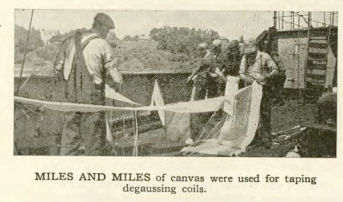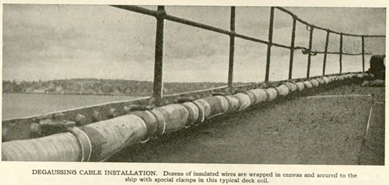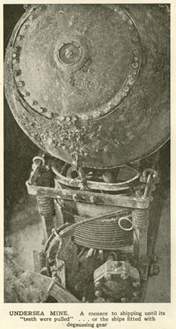Nova Scotia Light and Power employees purchased almost a million dollars, or one-seventh of the company’s payroll, worth of Victory Bonds and War Savings Certificates. One hundred and thirty-four employees of the Nova Scotia Light and Power company joined the armed forces—with ten making the ultimate sacrifice.
Halifax, the harbour city steeped in military history and boasting great naval facilities, became one of the key ports for the whole Allied campaign. Almost 57,000 ships would enter and clear the port over the war years. The population of Halifax more than doubled and Nova Scotians became central to the fight against the Nazis.
In the early days of the war, senior naval staff requested the assistance of NS Light and Power to implement a solution to a very pressing issue. The Nazis had begun to deploy high-tech magnetic undersea mines and torpedoes—the kind designed to seek and destroy the metal hull of Allied ships—and they were working. The Naval Service developed something to thwart the magnetic threat: A technology known as "degaussing".
This protective technology involved fitting a specially designed coil of insulated wires all around the outer rim of a ship’s deck and then connecting it to the ship’s generator. When active, this decreased or eliminated the magnetic field emanating from the ship. To give you an idea of the extent of the job, almost 50 kilometres of wire were required to outfit just one vessel. This work was to be completed on ships of all nations entering the Port of Halifax.

Originally asked to find and advise qualified contractors to complete this work, NS Light and Power found that there weren't any available for this monumental task due to the lack of qualified personnel with so many away overseas. Thus, the top-secret Marine Department of the NS Light and Power company was born. Ten days were allotted to prepare for the project, however, within one hour of receiving the Navy’s orders, emergency repairs to degaussing coils were required on a tanker destined to be part of the following morning’s convoy.
 As crews outfitted more and more ships of all types and origins, the struggle against the Nazis’ magnetic menace was being won slowly but surely—degaussing was working well. At the same time, so-called wolfpacks of German submarines, or U-boats, were wreaking havoc against Allied convoys in the Atlantic. NS Light and Power’s Marine Department was once again called upon to install various alarm systems and telephonic systems to better protect vessels and prepare sailors to defend themselves against these submarines. Other top-secret tasks included installing devices used to safely explode identified subsea mines, work on sound-acoustic gear for protection against acoustically activated mines, and even collaboration on the then-cutting edge naval radar program.
As crews outfitted more and more ships of all types and origins, the struggle against the Nazis’ magnetic menace was being won slowly but surely—degaussing was working well. At the same time, so-called wolfpacks of German submarines, or U-boats, were wreaking havoc against Allied convoys in the Atlantic. NS Light and Power’s Marine Department was once again called upon to install various alarm systems and telephonic systems to better protect vessels and prepare sailors to defend themselves against these submarines. Other top-secret tasks included installing devices used to safely explode identified subsea mines, work on sound-acoustic gear for protection against acoustically activated mines, and even collaboration on the then-cutting edge naval radar program.
Over the course of the war, untold numbers of employees were involved in this, and other high stakes work crucial in fighting the enemy and protecting troops and merchant sailors at sea. Jobs were done on merchant and naval ships of all shapes and sizes, like troop ships, patrol vessels, battle ships, and the mighty RMS Queen Elizabeth. Throughout World War II, NS Light and Power employees worked on over 1,600 ships flying the flags of 19 different nations.
The story of NS Light and Power’s top-secret marine protection work is fascinating and little-known, but the war efforts of the Nova Scotia Light and Power company and its employees were numerous and truly tireless.
This Remembrance Day, we thank and honour all those who serve or have served our country and contributed to our national defence—both today and throughout history.




 When Germany invaded Poland in 1939, humankind was—for the second time in the 20th century—plunged into a global conflict. World War II would rage for six long years and the fight against fascism was one forged not only by Allied soldiers but by each and every citizen.
When Germany invaded Poland in 1939, humankind was—for the second time in the 20th century—plunged into a global conflict. World War II would rage for six long years and the fight against fascism was one forged not only by Allied soldiers but by each and every citizen.
 As crews outfitted more and more ships of all types and origins, the struggle against the Nazis’ magnetic menace was being won slowly but surely—degaussing was working well. At the same time, so-called wolfpacks of German submarines, or U-boats, were wreaking havoc against Allied convoys in the Atlantic. NS Light and Power’s Marine Department was once again called upon to install various alarm systems and telephonic systems to better protect vessels and prepare sailors to defend themselves against these submarines. Other top-secret tasks included installing devices used to safely explode identified subsea mines, work on sound-acoustic gear for protection against acoustically activated mines, and even collaboration on the then-cutting edge naval radar program.
As crews outfitted more and more ships of all types and origins, the struggle against the Nazis’ magnetic menace was being won slowly but surely—degaussing was working well. At the same time, so-called wolfpacks of German submarines, or U-boats, were wreaking havoc against Allied convoys in the Atlantic. NS Light and Power’s Marine Department was once again called upon to install various alarm systems and telephonic systems to better protect vessels and prepare sailors to defend themselves against these submarines. Other top-secret tasks included installing devices used to safely explode identified subsea mines, work on sound-acoustic gear for protection against acoustically activated mines, and even collaboration on the then-cutting edge naval radar program. 
